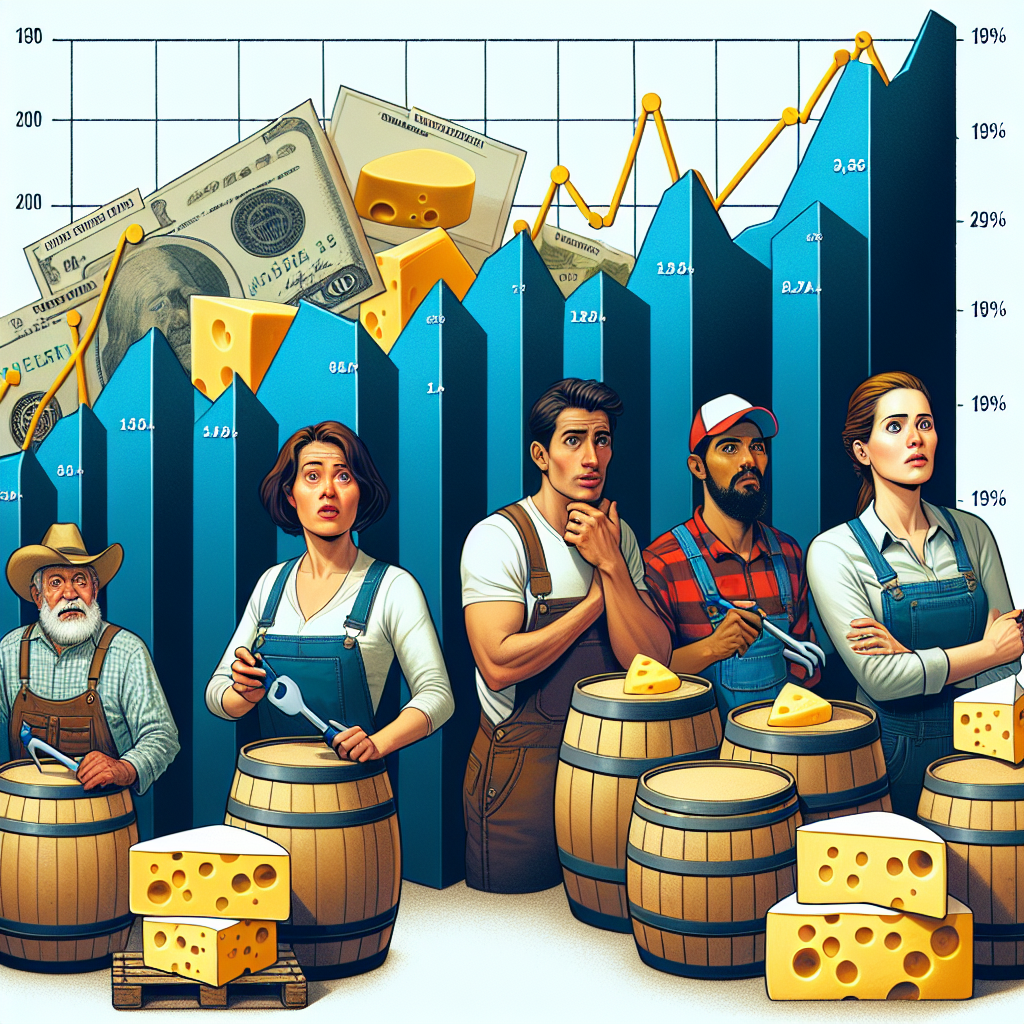Butterfat booms as cheese falters! USDA data reveals component gold rush amid powder glut and herd consolidation. Can your dairy survive 2025’s chaos?
EXECUTIVE SUMMARY: The February 2025 USDA Dairy Products Report reveals a market at odds with itself: butter production surged 2.6% YoY while cheese fell 2.2%, signaling a decisive shift toward component-driven profitability. Skyrocketing NFDM inventories (+57% YoY) threaten skim milk values, while dry whey’s unexpected domestic demand offers limited relief. Structural pressures intensify as mega-dairies (1,000+ cows) now control 66% of U.S. milk sales.
KEY TAKEAWAYS:
- Component warfare pays: Butterfat-focused operations gain 6.3% price advantage as processors redirect milk components
- Powder crisis looms: NFDM stockpiles hit 5-year highs (+57% YoY), threatening Q3 milk checks
- Consolidation accelerates: 82K new cows added since June 2024, with large herds dominating 2/3 of market share
- Survival playbook: Lock feed costs, hedge 40-60% of Q2 milk, and adopt Texas’ 4.5% BF nutrition strategies
- Biosecurity imperative: 40% of HPAI-hit herds recover only with strict protocols as new variants spread

The February 2025 USDA Dairy Products Report presents a complex picture for dairy farmers, with production statistics showing mixed trends that directly impact farm profitability, future planning, and market strategy. Let’s dive into what these numbers really mean for your operation and how to position yourself for success.
February 2025 Key Metrics Summary
| Product | Production | YoY Δ | Stocks | YoY Stock Δ |
| Cheese | 1,115M lbs | -2.2% | N/A | N/A |
| Butter | 203M lbs | +2.6% | N/A | N/A |
| NFDM | 147M lbs | -0.3% | 329M lbs | +57% |
| Dry Whey | 60M lbs | -16.7% | 62.7M lbs | -13.9% |
The Butterfat Bonanza: Why Cheese’s Loss is Your Milk Check’s Gain

Despite “VERY strong component production” in February, most dairy products fell short of forecasted production levels. This disconnect between components and finished products creates a strategic opportunity for component-focused producers.
Butter production reached 203 million pounds, exceeding forecast by 3 million pounds and jumping 2.6% year-over-year. Meanwhile, cheese production came in at 1,115 million pounds, 6 million pounds below forecast and down 2.2% year-over-year.
Why should you care? Because the market is sending a clear signal: butterfat is king. The report notes that “weaker cheese, ice cream and sour cream production freed up some fat for butter,” showing how processors are actively reallocating components to their highest-value use. For your operation, this means:
- Component pricing will continue to favor high butterfat production
- The Jersey and crossbreeding strategies gaining popularity in Texas mega-dairies are paying off
- Your nutrition program should prioritize fat-boosting additives NOW
Historical Component Growth vs Milk Volume
| Metric (Annual Growth) | 2016-2024 Avg | 2025 Forecast |
| Milk Production | 0.9% | 0.5% |
| Butterfat Production | 2.2% | 2.3% |
| Protein Production | 1.5% | 1.5% |
Powder Glut: Is Your Protein Check About to Crash?

The powder segment presents alarming inventory dynamics that could hit your milk check hard. NFDM stocks held by manufacturers hit 329 million pounds, a staggering 57% increase from February 2024. This massive inventory buildup, combined with “weak exports,” signals serious downward pressure on skim milk values.
Dry whey production surprised analysts by coming in 9 million pounds under forecast and down 16.7% year-over-year. However, whey stocks were lower than expected, suggesting “domestic buyers stepped up as prices were coming down”.
Think the export market will save us? Think again. With Canada’s tariff pause expiring March 4 and Mexico threatening to target $1.13 billion in cheese imports, international markets look increasingly unstable. Smart producers are already pivoting toward Southeast Asian markets, where demand has grown 9% despite global challenges.
Herd Math: Can Small Farms Survive the 1,000+ Cow Takeover?
The dairy industry faces significant structural challenges. Large operations with 1,000+ cows now account for 66% of all US milk sales, up from 57% in 2017. Meanwhile, the national dairy herd continues expanding, with producers adding another 15,000 head in February, bringing total recovery to 82,000 head since June 2024.
For smaller and mid-sized producers, these trends create an urgent need to:
- Find differentiated markets or premium opportunities
- Consider cooperative structures that strengthen producer position
- Evaluate whether expansion is viable against market realities
Ontario Dairy Efficiency Comparison (1966 vs 2024)
| Metric | 1966 | 2024 | Change |
| Farms | 40,420 | 3,187 | -92.1% |
| Cows/Farm | 22 | 100 | +354% |
| Milk/Cow (liters) | 3,415 | 9,946 | +191% |
| Total Production (B L) | 3.08 | 3.18 | +3.2% |
Component Warfare: Your Farm’s Survival Strategy
With the USDA’s 2025 dairy forecast showing the all-milk price revised upward to $22.75 per cwt despite production challenges, the message is clear: farms focusing on butterfat and protein components will capture premium returns. This aligns with the February production report’s emphasis on strong component production despite lower-than-expected finished product volume.
Forget “average” milk—your farm’s future depends on butterfat warfare. Here’s the 3-supplement stack Texas mega-dairies use to crush 4.5% BF tests:
- Strategic rumen-protected fat supplementation
- Precision forage management focusing on digestible fiber
- Component-targeted genetics selection
USDA 2025 Milk Production Forecast
| Metric | 2024 Actual | 2025 Forecast | Change |
| All-Milk Price ($/cwt) | $22.40 | $22.75 | +1.6% |
| Milk Production (B lbs) | 225.6 | 226.9 | +0.5% |
| Dairy Herd Size (M head) | 9.347 | 9.369 | +0.4% |
| Butterfat Growth Rate | 2.1% | 2.3% | +0.2 pts |
| Protein Growth Rate | 1.4% | 1.5% | +0.1 pts |
Market Volatility and External Pressures
Recent tariff implementations have added uncertainty to an already volatile dairy market. The clock’s ticking on Canada’s tariff pause, which expires March 4—and Mexico’s threatening to nuke $1.13B in cheese buys. Got a Plan B?
The current environment features:
- Downward pressure on feed prices, potentially improving margins (down 10.1% to $62.4 billion in 2025)
- Labor costs surging upward by 3.6% to a record $53.5 billion
- Butter prices at their lowest since 2023
- Production “running strong” on the supply side
HPAI Crisis: Is Your Biosecurity Ready?
California’s HPAI crisis has slashed the state’s production by 5.7%, far worse than the forecasted 3.0% drop. With 747 herds affected and two variants (B3.13 and D1.1) circulating, biosecurity isn’t optional—it’s survival. The good news? About 40% of affected herds recover within 60 days, but only with proper protocols in place.
Strategic Action Plan for 2025
With China’s demand collapsing (-7% imports) and Argentina’s production surging (+5.6%), now is the time to:
- Lock in feed costs while grain markets remain favorable
- Hedge 40-60% of Q2 milk via futures to protect against spring flush price drops
- Slash labor costs through strategic automation—robotic milking systems are showing 3-year ROI in high-wage regions
- Diversify export relationships beyond traditional markets—Vietnam’s dairy imports just spiked 22%
The Bottom Line: Adapt or Perish
The February 2025 USDA Dairy Products Report provides dairy farmers with valuable data for operational decision-making in an increasingly complex market. The divergence between strong component production and lower-than-expected product volumes sends mixed signals about market strength. However, the continued premium for components, particularly butterfat, suggests farmers should maintain focus on component optimization.
External factors including tariffs, industry consolidation, and consumer demands for sustainability create additional challenges. In this environment, successful dairy farmers will need to balance component-focused production strategies with cost management, market awareness, and operational flexibility.
The clock’s ticking: Will you ride the butterfat wave or drown in the whey glut? The producers who adapt fastest to these market signals will be the ones still standing when the dust settles.
Learn more:
- Dairy Markets on A Knife’s Edge: Spring 2025’s Make-Or-Break Moment for Producers
Explore how surging milk production and plummeting prices are squeezing margins, while regional disparities and export opportunities shape the future for dairy producers. - Why Boosting Butterfat and Protein Is Key to Higher Profits
Learn actionable strategies for increasing butterfat and protein levels in your herd to capitalize on component-driven profitability trends. - USDA Predicts US Leads Global Milk Production Growth Despite European Challenges in 2025
Understand how the U.S. is positioned to lead global milk production growth, driven by technological advancements and selective breeding, despite international challenges.
 Join the Revolution!
Join the Revolution!
Join over 30,000 successful dairy professionals who rely on Bullvine Daily for their competitive edge. Delivered directly to your inbox each week, our exclusive industry insights help you make smarter decisions while saving precious hours every week. Never miss critical updates on milk production trends, breakthrough technologies, and profit-boosting strategies that top producers are already implementing. Subscribe now to transform your dairy operation’s efficiency and profitability—your future success is just one click away.







 Join the Revolution!
Join the Revolution!









